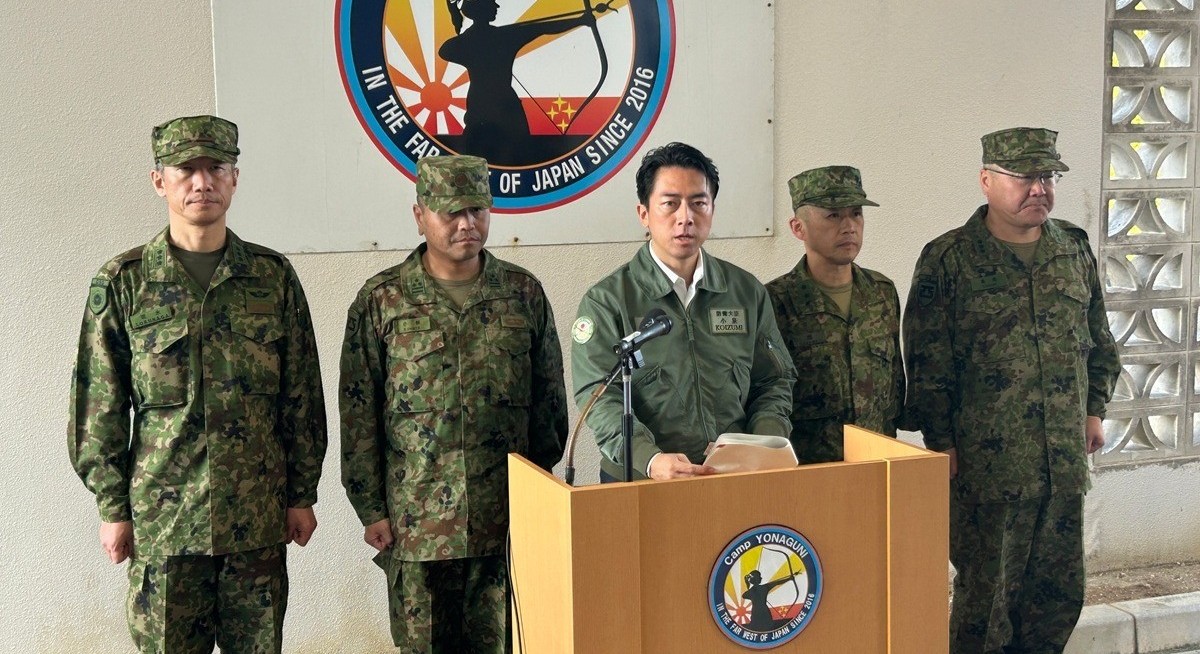(Nov 23): Japan’s defense minister, visiting a military base close to Taiwan, said plans to deploy missiles to the post would move forward as tensions smolder between Tokyo and Beijing over the East Asian island.
“The deployment can help lower the chance of an armed attack on our country,” Shinjiro Koizumi told reporters on Sunday, as he wrapped up his first trip to the base on the southern Japanese island of Yonaguni. “The view that it will heighten regional tensions is not accurate.”
In January, former defence minister Gen Nakatani said Tokyo wanted to base Type 03 Chu-SAM missiles on Yonaguni, but little progress has been made so far. The truck-launched missiles are designed to counter air threats up to 30 miles (48 kilometrers) away.
Koizumi, who took over as defence minister last month, said on Sunday that the ministry was still working on the plan and would share details with the local government and people of Yonaguni when details are finalised.
China’s Foreign Ministry didn’t immediately respond to a request for comment. Taiwan’s Foreign Ministry referred the inquiry to the Defense Ministry, which also didn’t immediately respond.
See also: China asks airlines to extend Japan flight cuts until March next year — Bloomberg
The plan to station medium-range surface-to-air missiles on Yonaguni, about 110 kilometres east of Taiwan, comes as part of a broader military build-up on its southern island chain. The moves reflect Tokyo’s concerns about China’s growing military power and the potential for a clash over Taiwan.
When China responded to a visit to Taiwan by then-US House Speaker Nancy Pelosi in 2022 by launching major military drills around the island, ballistic missiles landed just south of Yonaguni, providing a stark illustration of the proximity of the island to any conflict for control of Taiwan.
Japan’s fears of being embroiled in a Taiwan conflict were amplified by a dispute over recent comments by Prime Minister Sanae Takaichi related to the self-ruling territory, which Beijing regards as a province that must be brought under its control, by force if necessary. Takaichi on Nov 7 raised the theoretical possibility that Japan could deploy its military with other nations if China attacked Taiwan, drawing an angry response and economic retaliation from Beijing.
See also: Taiwan pleased Trump didn’t mention island in readout of Xi call
She has since reverted to the government’s longstanding policy of not discussing particular scenarios that might involve Tokyo’s military, but Beijing continues to demand a retraction. On Saturday, a Japanese official rejected China’s claims that Takaichi has altered Japan’s position on a Taiwan crisis as “entirely baseless.”
The spat is adding to risks in Japanese markets, which are already under pressure from Takaichi’s plans to boost government spending and a selloff in technology stocks. Verbal sparring may increase choppiness in the yen at a time when Japanese officials have increased warnings to traders over sharp moves. Defence-related stocks are likely to come into renewed focus and may benefit when trading resumes on Tuesday, following a tumultuous week that saw about US$127 billion ($166 billion) wiped off the value of Tokyo-listed stocks.
When asked over the weekend about the potential impact on Yonaguni of a Taiwan crisis, Koizumi said he wouldn’t comment on hypothetical scenarios.
Before arriving in Yonaguni, Koizumi visited bases on the islands of Ishigaki and Miyako. The Ishigaki base is equipped with anti-ship missiles, while Miyako is a hub for air surveillance and other military facilities, including ammunition storage. Japan and the US also have major bases on the larger island of Okinawa further to the east.
A popular tourist retreat including for scuba divers, Yonaguni is also home to a surveillance radar facility that scans nearby seas and airspace, as well as an electronic warfare unit introduced in 2024 that could be used to jam enemy communications and guidance systems.
In recent weeks, the US military held a training exercise to bring supplies from Okinawa to Yonaguni to simulate the creation of a forward-operating base that might be needed in any regional crisis.
In a meeting with the mayor of Yonaguni, Koizumi said Japan has to build up its deterrence by increasing its own capabilities and deepening ties with the US military.
To stay ahead of Singapore and the region’s corporate and economic trends, click here for Latest Section
‘Most severe’
“Today, Japan faces the most severe and complex security environment since the end of World War II,” Koizumi said. “To protect the peaceful livelihoods of the Japanese people — including everyone here on Yonaguni — we must strengthen the Self-Defense Forces’ capabilities.”
Yonaguni is the end point of the Ryukyu island chain that stretches several hundred miles from the Japanese mainland. As tensions with China intensified in recent days, Chinese state-controlled media have published articles questioning Japan’s sovereignty over the islands and highlighting how the Ryukyu Kingdom was independent from Japan several hundred years ago.
Few residents of the Ryukyu islands, also known as Okinawa Prefecture, seek independence but they’re wary of being embroiled in a regional conflict if military facilities on the islands are targeted.
Uploaded by Liza Shireen Koshy





